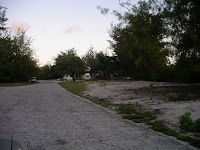Christmas Island is part of the Line Island Group which are part of the Republic of Kiribati. The Republic includes 32 atolls and one raised coral Island. The Republic of Kiribati covers approximately 3,500,000 sq kilometres in the Pacific Ocean. The present imaginary International Date Line, defined in 1995, takes an enormous step to the east to encompass the Line Islands and the easternmost of the group has been re-named Millenium Island as it was the first to greet the new Millenium.
All this is rather useless geography, except for those who live there and for those who struggle with what day it is and what time it is when following the course we took. For me, it was impossible trying to work out the day, date and time with the added complication of daylight saving thrown in. As a brief summary, we left Hilo and after a 7.8 hour flight, landed at Christmas Island almost a day later. We then headed west to Pago Pago where after an 8.2 hour flight, we landed a day earlier than we left. After a 9.6 hour flight from Pago Pago we landed at Noumea about a day later. Flying roughly south west we crossed the International Date Line three time.
Not a geography or history lesson but the Christmas Island people lead a subsistance life, with little to trade and little to trade with. Their island is the largest coral atoll in the world. The airport is 5' above sea level. Its highest point is 42'. Christmas Island will be the first to go under IF the oceans rise. Its towns are named Paris, London & Poland. It was used by the Japanese and English for NASA space studies and was used for testing nuclear weapons in the 1950s & 1960s. People were not allowed to live permanently on the island until 1979. 4000 US soldiers died in one day taking nearby Tarawa Island from the Japanese, and given the isolation, one can but wonder why?
The bures in which we slept were about 10 metres from the edge of the ocean. They were left as part of the hotel complex built by the Japanese for the scientists. The resident's houses are largely built using materials such as timber, iron, plaster board scavenged from the abandoned buildings.
Fishing is apparently great, with fly fishing from the beach being a particular attraction. We dined with a sunburnt Canadian who appeared to be the only other hotel guest but he told us of another 4 fishermen who were also on the island.The hotel served an excellent meal which included baked whole fish, lobster with a number of side dishes followed by cake and ice cream.
The evening meals were enjoyable, because other than at Hilo, we did not have breakfast on any day and our lunch consisted of muesli bars or stewed fruit, chips or nuts with water or fruit juice and later in the flight the obligitory can of heart pounding Red Bull.
 At Christmas Island, I started to realise the complexity and formalities involved in ferrying aircraft through different countries, each with its own immigration policies and procedures. There was also the Declarations which were required by the Countries with forms requiring details of whatever it is they needed to let us in and out. At some airports we were met with Customs, Immigration, our equivalent of AQIS and all of these organisations had to be advised in advance of the date and time of our arrival, sometimes with forms lodged prior to arrival.
At Christmas Island, I started to realise the complexity and formalities involved in ferrying aircraft through different countries, each with its own immigration policies and procedures. There was also the Declarations which were required by the Countries with forms requiring details of whatever it is they needed to let us in and out. At some airports we were met with Customs, Immigration, our equivalent of AQIS and all of these organisations had to be advised in advance of the date and time of our arrival, sometimes with forms lodged prior to arrival.In addition the fuel had to be pre-arranged and in the case of Christmas Island, the fuel was obtained primarily for and at the request of the ferry organisation. Whilst an individual could probably bring an aircraft from US to Australia, it would take months of preparation and organisation and would then probably be very difficult without the contacts and relationships developed over many years. In Ray Clamback's case, he has been ferrying aircraft for 40 years and has probably over 300 crossing. He says there are two Australian ferry pilots who have done more crossings than he has.

I also started to appreciate why the cost was what it is. A very rough guesstimate of the fuel costs for the Saratoga would be around $10,000 and on top there are landing and airport fees, accommodation, food, wages etc.
Having confirmed the specks on the windscreen were grease from the hub of the propellor we were ready to depart at sunrise.
Click on images to enlarge




No comments:
Post a Comment